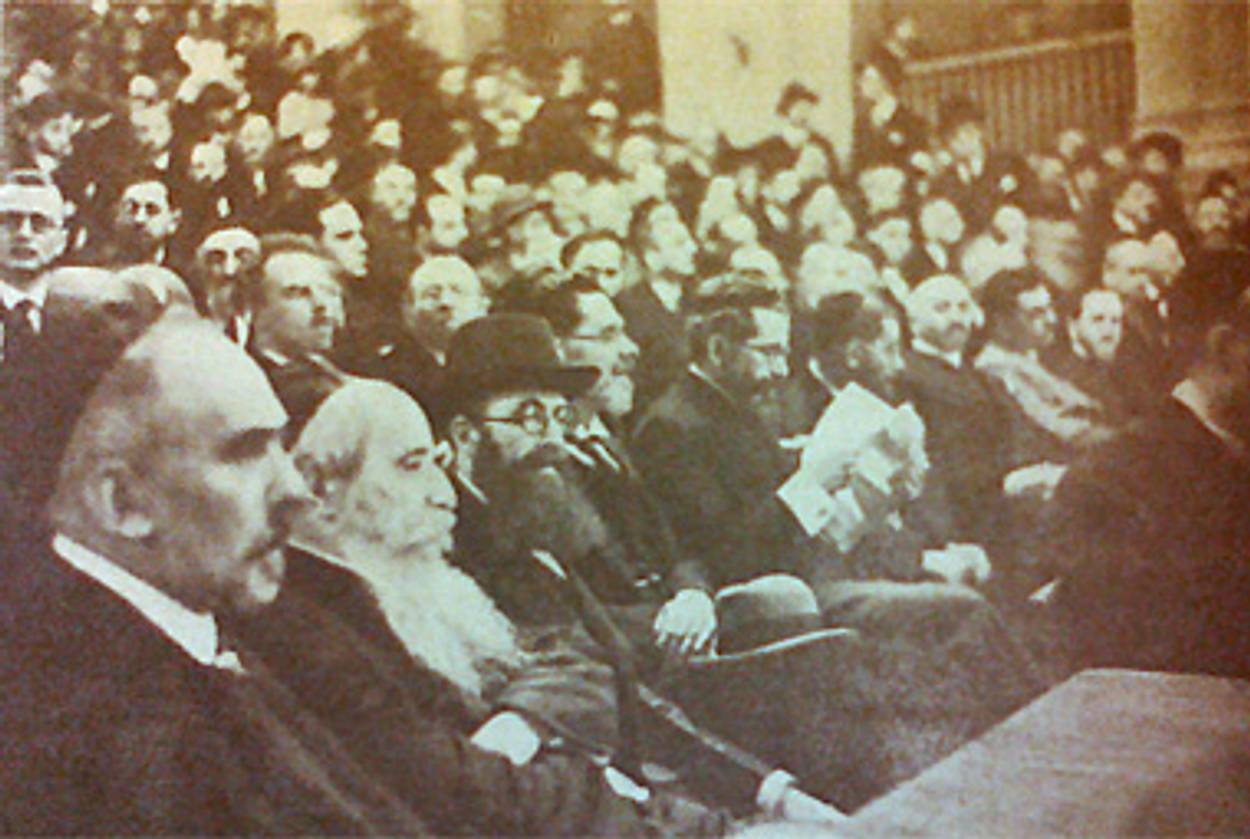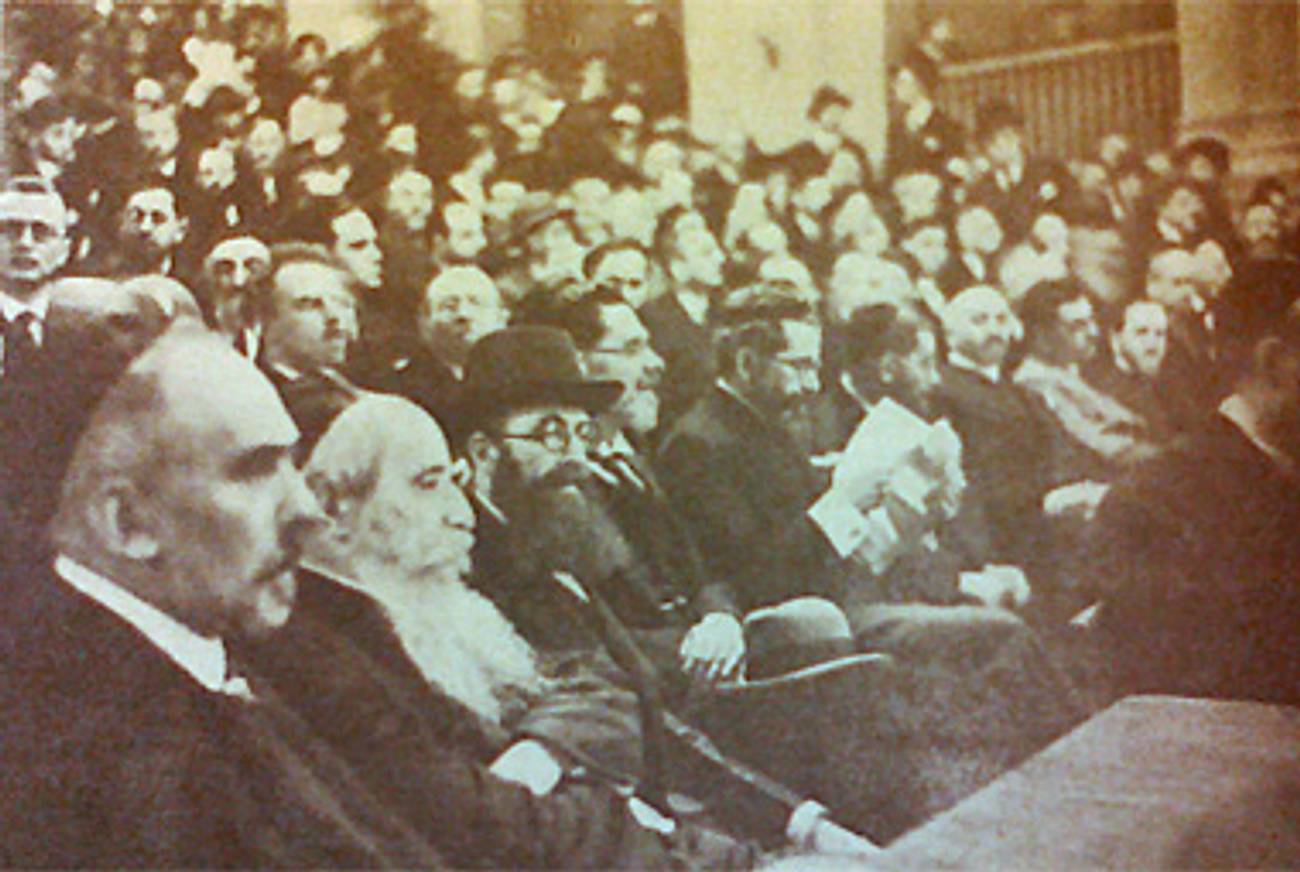Enforcers
In early-20th-century Warsaw, making sure people observed the Sabbath was serious business




One of the convenient aspects of studying Jewish history is its 3,000-year-old paper trail—the texts and records of the rabbinical and intellectual elite allow us to examine contours of Jewish law and history. But we tend to know less about the lives of average Jews, who didn’t receive much attention in the writings of the intellectuals. That began to change in the late 19th century, when the Yiddish press hit the streets, for the first time recounting the lives of the unwashed masses of Jews in the public record. Tablet Magazine offers some of these stories.
The holiest of Jewish holidays isn’t Rosh Hashanah or Yom Kippur. It’s Shabbat, a holy day so important that it ranks on God’s top ten list. The Sabbath is mentioned a dozen times in the Torah, far more than any other commandment. The Talmud claims that remembering the Sabbath and keeping it holy is like observing all 613 commandments at once, which is why, as we learn in The Big Lebowski, religious Jews absolutely do not roll on the day of rest.
For those dedicated to the commandment’s full implementation, the Sabbath is something that must be protected against any infraction, no matter how minute. As recently as last year, a group of religious Jews in Jerusalem violently protested the operation of a parking lot on Shabbat. The people who took part in the action are the latest incarnation of Shomrei Shabbos, “Guardians of the Sabbath,” or, “Sabbath Enforcers.” The Enforcers have their distant origins in the medieval character known as the klopper, the man in the shtetl whose job it was to walk about the village and bang on the Jews’ houses to let them know it was time to close up shop because Shabbos was beginning.
This form of public communal cultural preservation was particularly tested during the urbanization of the 19th century. When Jews opened businesses, there were always those Shabbos enthusiasts who made the rounds on Friday evenings making sure Jewish shops were shut down. Infractions were often met with threats of boycotts and violence. The holy day was not something to take lightly.
As secular Yiddish groups like women’s rights organizations and sports clubs established themselves in the early 20th century, so too did Orthodox groups begin formalizing their unions. Chief among them was the establishment of an official Shomrei Shabbos organization. After the organization was founded, at a conference in Berlin in 1929 by a group of German rabbis, religious Jews from many countries soon joined, all agreeing that desecration of the Sabbath was on the rise as a result of the nature of modern life—forced store and factory closures on Sundays required Jews to work on Saturdays. Rabbis at the conference sought a way to ensure Sabbath observance among Jews who had no choice but to work on the day of rest. They considered petitioning governments to allow a day off on Saturday and to work instead on Sunday.
In 1930, a second, much larger Shomrei Shabbos conference was held, also in Berlin. Some 2,000 people attended the event, and, by then, the Shomrei Shabbos were active in more than 21 countries. Among ideas floated at the event was a proposal to approach the League of Nations about making Sabbath rest an international priority and the suggestion of creating a Shabbos Encyclopedia, which would examine the history of Saturday work stoppages from biblical times to the present. Famed poet Chaim Nachman Bialik promised to contribute an article.
Geared to helping Jews who wanted to but couldn’t observe Shabbos, the conference did not take into account people who cared nothing for the day of rest, or those who might purposely break it as part of their political or social ideology. But, as Asher Ginsburg (aka Ahad Ha’am) once noted, “Shabbos keeps Jews more than the Jews keep Shabbos.” To the Enforcers on the streets of Warsaw, this was a matter of national concern. They had no qualms about cracking skulls for the sake of Shabbos and, occasionally, breaking it in order to keep it whole.
The Yiddish press is full of incidents involving the Enforcers. In August 1927, the Yiddish daily Moment told the story of a young Jew riding a bicycle through a heavily Hasidic neighborhood of Warsaw on a Saturday. It was just before noon, when synagogue services typically ended and thousands of congregants spilled into the streets. As the young rider approached the corner of Tvarda and Marianska Streets, a Hasid saw him and screamed, “Mekhalel-shabesnik!” (“Shabbat breaker!”) at the top of his lungs, and hurled himself off the sidewalk to block-tackle the cyclist.
“A bitter holy war began to play out,” Moment’s reporter wrote, as the cyclist got up and began to argue with his assailant. The cyclist was furious at being smashed to the ground. The Hasid, meanwhile, was equally angry at the public flouting of the holy day. The two began throwing punches, and Hasidic bystanders joined in, taking their own swings at the biker, for “the honor of the Sabbath,” Moment reported. The Hasidim “saw fit to ‘get even’ with the young man’s bicycle, breaking spokes and bending the frame and wheels until it was transformed into a heap of junk.”
Eventually, the police showed up to drive the large crowd away. They arrested the cyclist and his attackers and lugged the smashed bike back to the precinct as evidence. While Baghdadi Rabbi Chaim Yosef, also known as Ben Ish Chai, the same name he gave to his 19th-century halakhic treatise, wrote that bicycle riding is permitted on the Sabbath within the confines of an eruv, Warsaw’s Hasidim seemed to know nothing about such a ruling.
Fear of arrests did not deter these Shabbos watchdogs. A year later, Moment reported on roving gangs of them every Friday evening. One particular night, they happened upon a Jewish boy at the corner of Gzhibovska and Granitshna Streets in Warsaw shouting, “Buy ‘em ladies, pumpkin seeds, fresh out of the oven, buy ’em now!”
One of the Enforcers walked over and calmly alerted the boy that Shabbos had begun and that he should stop selling the roasted seeds. The boy ignored him. What began as “moral advice from the Enforcer quickly turned into a physical threat,” according to Moment. While the Enforcer was yelling at the kid, a crowd grew. On one side were Jews on their way to synagogue. They were poised to drag the “mekhalel-shabesnik” into an alley and pound some sense into him. The other side consisted of people defending the alleged transgressor.
As in the earlier incident, the fight escalated, and soon people were screaming and smashing their canes over each other’s heads. Moment’s reporter doesn’t say what happened to the peddler-boy during the fracas but does tell us when the police arrived they arrested a half a dozen people who spent Shabbos in the clink.
The melee didn’t stop other Enforcers from continuing to prowl that evening, and, “after determining that the Jewish seltzer stands on Tvarda Street were indeed closed,” they came upon a young couple on a date. While a Shabbos rendez-vous does not qualify as a transgression, it turned out that the young man was smoking a cigarette—an act that necessitated the lighting of a match, strictly prohibited on holidays.
One of the Enforcers flew into a rage upon seeing the smoker, snatched the smoker’s hat off his head, threw it to the ground, and stomped on it. The victim, as Moment dutifully reported, “was baffled and didn’t quite know how to react. His date, on the other hand, was a real eyshes khayel—a woman of valor. She knew exactly what was happening and jumped on the Enforcer, scratched his face like a cat, and tore out a hefty chunk of his beard.” The Enforcer, Moment continued, let out a “blood-curdling scream which brought hundreds of people into the street, crowding it so much that the tram was unable to get through.” The police finally arrived and arrested everyone involved.
The Enforcers did not only antagonize relations between religious and secular Jews in interwar Poland. Sometimes, they used their powers to deal with internal matters.
Take, for example, the May 1933 case of Yoel Weiderfeld, a well-off Hasidic landlord. According to Moment, Weiderfeld had evicted a family with six small children from an apartment, throwing them into the street. Though local Hasidim tried to get Weiderfeld to reconsider his decision, the landlord remained unmoved.
Not so the Shabbos Enforcers, who sprang into action. On a Friday night, while Weiderfeld was at his shtibl greeting Shabbos, the Enforcers moved the poor family, “together with their meager belongings, back into their apartment.”
When Weiderfeld found out about it, he was furious and vowed to initiate new eviction procedures. But the Shabbos Enforcers remained on the case. “When the landlord went to pray that Shabbos morning, the other worshippers asked of him that he allow the poor renter back in,” Moment reported. They also tried to delay Torah reading until Weiderfeld agreed to allow the family to remain. But the landlord was a stubborn sort and steadfastly refused their entreaties.
Without other recourse, the Enforcers’ next move was to grab Weiderfeld’s tallis, wrap it around his head, throw him over a bench, and start punching his back and buttocks—a Yiddish underworld tactic known as “aroysnemen a mashkante,” taking out a mortgage, on someone. In spite of the serious shellacking, the landlord freed himself and fled the synagogue to a nearby pharmacy, where he called the police—himself violating Shabbos. Instead of returning to shul, he engaged the services of the law, who again, Moment continued, “threw the poor family out of the apartment—on Shabbos, no less.”
Condoned by the most important rabbis, the street-level tactics of the Enforcers remain a violent inheritance today. While the contradiction inherent in their aggression seems to elude them, their desire to protect, defend, and enforce the Sabbath remains paramount: While they’re around, they’ll see to it nobody rolls on day of rest.
Eddy Portnoy, a contributing editor for Tablet Magazine, is the Academic Advisor and Exhibitions Curator at the YIVO Institute for Jewish Research. He is also the author of Bad Rabbi and Other Strange but True Stories from the Yiddish Press.
Eddy Portnoy is academic adviser and director of exhibitions at the YIVO Institute for Jewish Research, as well as the author of Bad Rabbi and Other Strange but True Stories from the Yiddish Press (Stanford University Press 2017).